Historical Album of JR1MAF

[The last renewal of this page: November 4, 2010]
== 1968-1971 ==
Very hard times being a senior high student. I could meet the ham radio where I could talk with U.S. people in English, but no way to buy radio
equipment without money. To make the matter worse, I had to study hard to pass the exam for University. Suffering from mental agony, I worked 50MHz AM with local
friends, and also tried to build 50MHz AM/FM transmitter/receiver and CW/AM transmitter for HF bands to let off steam. My school record was getting lower, but
my passion to talk with U.S. people was getting stronger day by day. Strangely, no pictures being taken are left in those days. It was absolutely dark age for me.
== 1972 ==
Right after I entered a University, still using homebrew radios which I built in senior high days. Radios in this picture are 50MHz
10W AM/FM transitter using 2E26 in final, Receiver (RF1+IF2) with a X'tal converter for 50MHz built in, and a VFO. They all are all tube
equipments.
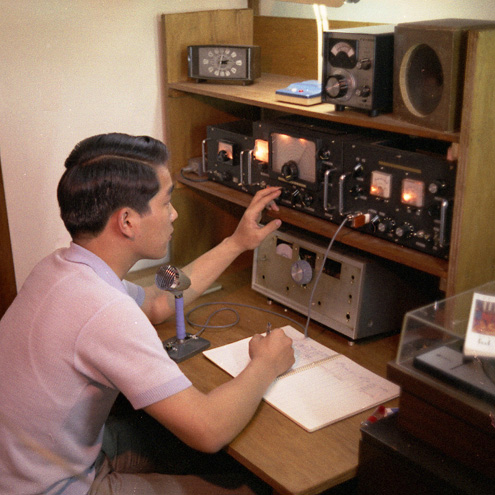
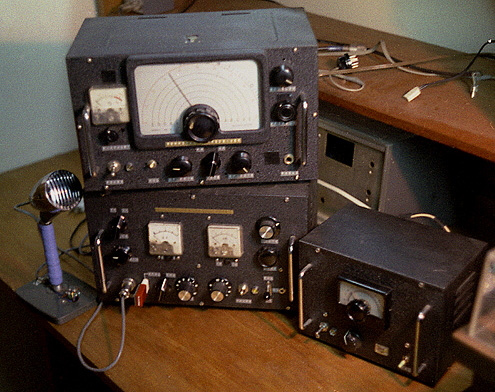
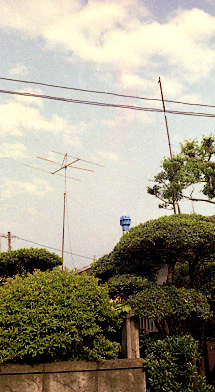
The antenna was a 5 element Yagi for 50MHz (Rotable by hand opening the window of the shack.), and an Inverted-V antenna for 7MHz being installed ont eh top of the roof.
== 1972-79 ==
Worked hard with a part-time job, and finally got TRIO(former KENWOOD) TS-520D. ( I firstly bought YAESU FT-401D, but I sold it in a short time,
as I could not satisfied with it.)
Sugiura Shokai, a radio shop near the Tachikawa Base was selling many used military use radios used in the Vietnam War, and therefore I could
purchase super-excellent radio parts there in these days. I built a powerful linear amplifire using these parts, using four DX-362 (same as 4CX350).
The antenna was two element Quad mounted on the wooden ladder tower 12 meters high.
My dream for years at last came true, and I was devoted to enjoy chatting with U.S. stations for 2 or 3 hours everyday. I met Ray, KL7CYH(later KL7C) who gave me a great influence and changed my life in these days, and started everyday's schedule QSO on 14.292MHz.
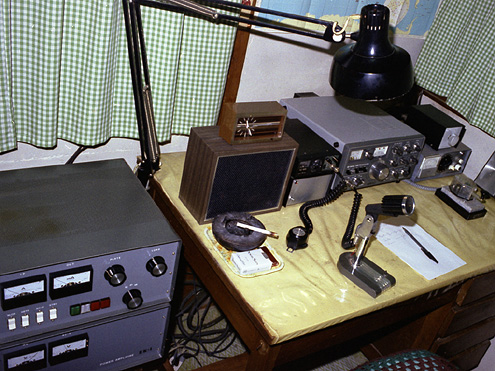
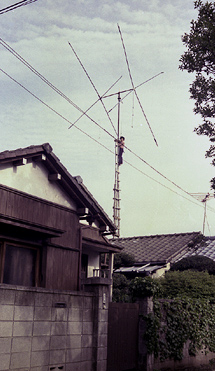
== 1980-81 ==
Shacks in Osaka where I was transfered due to my job. (Ashiya, Hyogo Prefcture/Takatsuki, Osaka)
The excellent propagations helped me to continue weekends ragchew with U.S. stations.
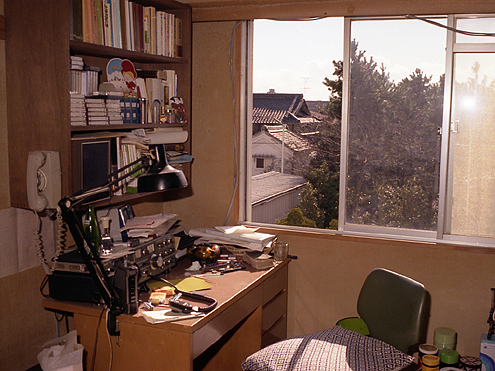
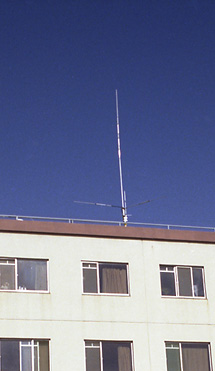
At the domitory, I put up a GP (HIDAKA VS-41/7-28MHz) on the top of the roof of four story dormitory.
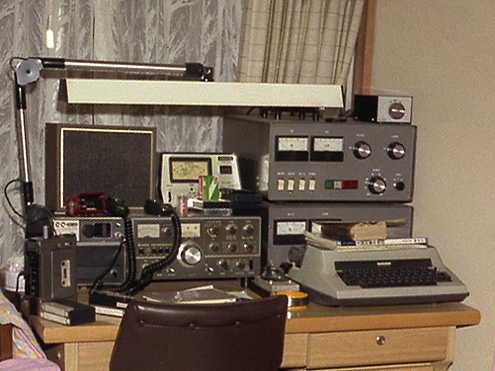
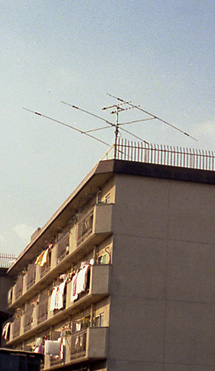
I got married in the next year, and moved to a condorminium in Takatsuki, Osaka. There, I put up a Moseley TA-33 (3ele Yagi for 14-28MHz) on the top of the roof of four story condorminium.
== 1982-86 ==
I got back to Tokyo from Osaka, but lived in a family-dormitory of my company in Kunitachi, Tokyo.
The antenna was a GP (DIAMOND DP-CP5/3.5~28MHz) mounted on top of the four story family-domitory. All neighbors were my colleagues, and therefore TVI problems were looked on with kindly tolerance.
I spend a few hours to talk with U.S. stations in every weekend. Many hams from overseas used to vist and stay with us in a small family-dormitory.
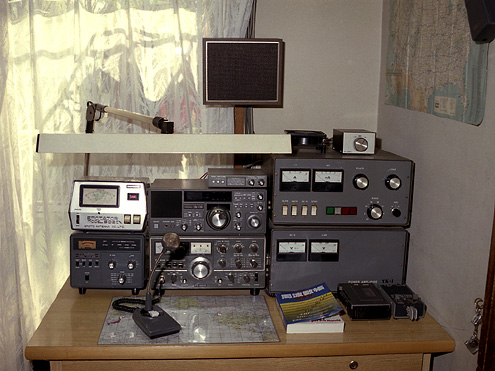
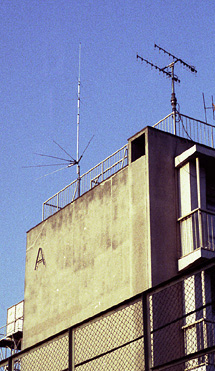
== 1987-90 ==
At the current QTH (Hanno, Saitama) I purchased a land and built a house.
I put up a crank-up tower 22mh, and mounted a four element Yagi for 14/21MHz (CREATE 214C), and completed an ideal radio staion at the first time since I started hamradio.
Radios are KENWOOD TS-940S and a linear amplifire TOKYO-HYPOWER HL-2K(3-500ZA X 2). The homebrew linear amplifire using DX362(4CX350) X 4 was much
powerful, but I had sold it to an enthusiastic local friend.
Enjoyed a lot ragchews with DX stations. Meanwhile, I wrote and designed a RBBS(Radio Bulettin Board System) host program, and started to run The JR1MAF-1 RBBS. (since 1987)
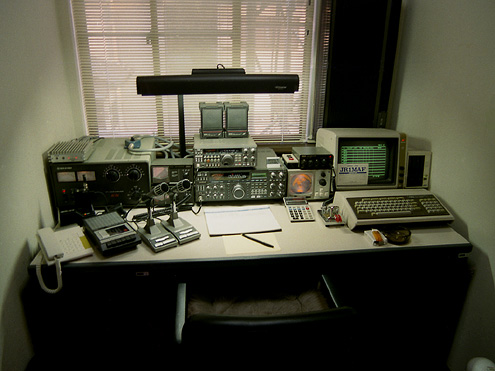
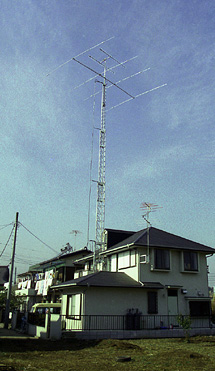
I designed a logbook software in BASIC for NEC PC-8001. It is very common that one call him with his name when he was called by a station who has worked before, but at that time no one could do so, then I was so satisfied with doing so.
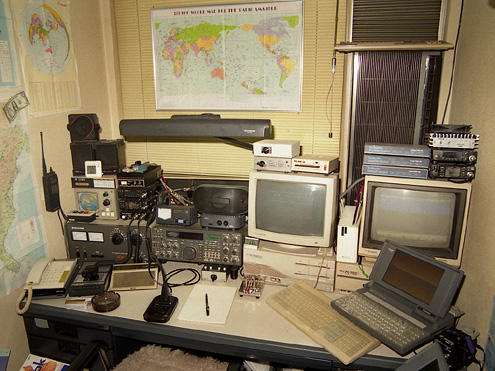
I designed RBBS (Radio Bulletin Board System) host software, adn run it on NEC PC-9801 (at the top, most right) for the JR1MAF-1 RBBS.
== 1991-1995 ==
Completed the integrated system with computers. I worked in all modes like SSTV, RTTY, Satellite, etc. I opened a node station of the PacketClusters as the 5th node in Japan, and I started to get a link with a node in Korea on 14MHz at the first time in Japan. The HF node was also used for direct acces from stations in Asia such as UAs, as well.
When the 18MHz band was released to the amateur as WARC, I felt a strong attractiveness to the band as a pioneer, and turned myself into a mono-bander. As there were very few stations to work that band seriously then, I was dasshing forward leading the band's activity. As a result, before long,
I lost the way, forgetting my idea and policy for the radio, "worldwide communication through ragchew" that I had been considering the most important for years. I was trying very hard to enlarge the facilities just for leading the DX competitions.
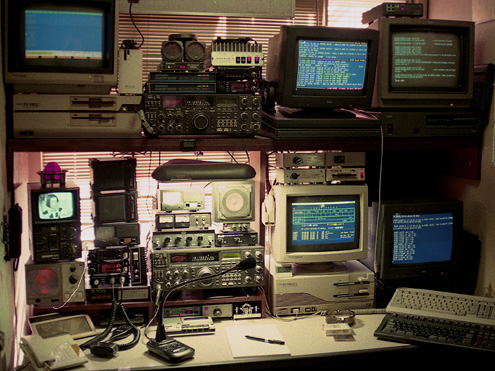
A PC at the up left is for RBBS "JR1MAF/MAFNET", and two PCs on the right are for a node of PacketCluster "JR1MAF-1". All the tranceivers and TNCs between them are for the host and node.
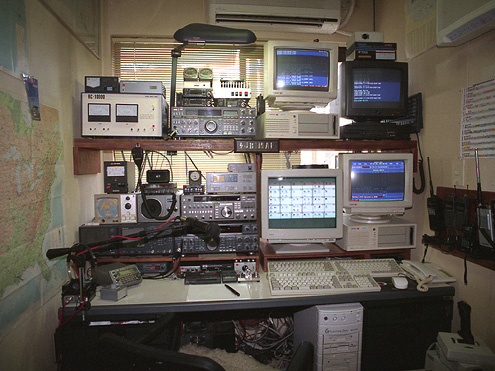
Shortly after, I started to limit and concentrate everthing into the Satellite and 18MHz only to go crazy. At the tope left, a controller for the linear amplifire which is installed in a cabin in the garden.
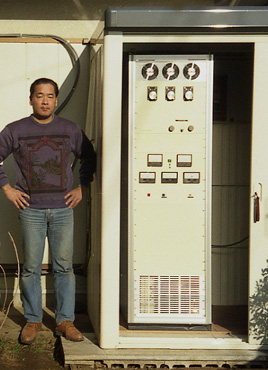
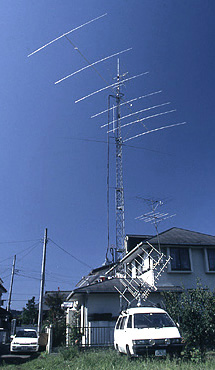
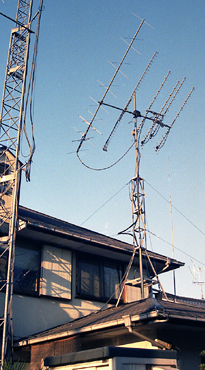
A liniear amplifire and a sattelite antenna system.
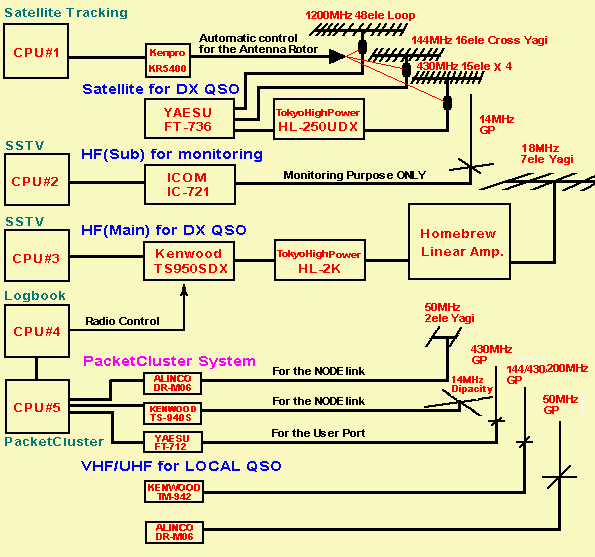
This is a system chart then.
== 1996-98 ==
You can not keeo the wrong and deviated orbit. Before long, I recognized what I was doing, facing the facts that I worked rare DXs solo, although I could not hear at all getting Q5 signal report from them. I was trying to control everything with a POWER for my satisfaction. I also recognized that my families were victim of my activities. Thus, I finally decided to sell a linear amplifire and quit chasing DX on 18MHz, and tried to get back to enjoy ragchew with DX stations on 14MHz, modifying the 7element Yagi for 18MHz into 5 element Yagi for 14MHz.
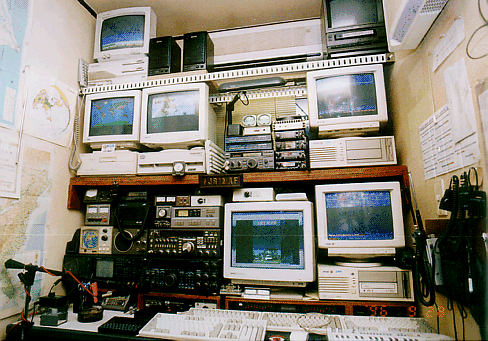
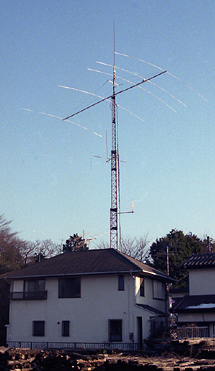
== 2009 ==
After then, I was interested in astronomy to chase small galaxies in deep space, and devoting myself to that world, losing interest and activities
for ham radio for about ten years.
After the homebrew wooden astronomical observatory in the garden was unabled to use any longer due to rain leaks, I happened to meet an old timer of
radio amateur in a bar in tha town, and had an opporunity to talk about old days, all tube radios. That experience switched on my interest back
again to the radio. I felt strong "roman"(nostalgia) in all tube AM radios in 1960's, feeling that they are the starting point of the radio amateur.
I started again ham radio setting new shack. At the same time, I knew the existance of VoIP, the Echolink, and excited about it, because that is
the best system for DX ragchew! I opened a node station on 430MHz, where I will never need a giant linear amplifire and a huge antenna again.
My main radios are all tube ideal lin-up in 1960's, now.
"The starting point of the amateur radio is a heart and a technology, and not to be the leading-edge and win in a competition."
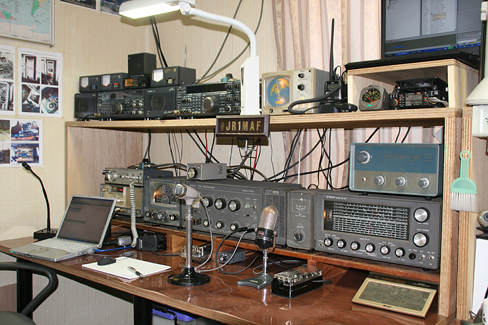
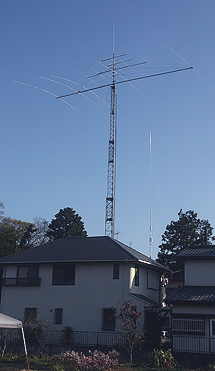
My old dream AM system, TRIO's TX-88A + VFO-1 + 9R59 + CC-6 + SM5, Nisshin's SKYELITE6, TRIO's TR-1000.
Antenna was a 5 element Yagi for 14MHz, and a vertical whip antenna with ATU (ICOM AH-4) as a sub-antenna for HF bands (3.5-28MHz). For 50MHz, a 6 element Yagi.
At the top right, the Echolink node system.
== Spring, 2010 ==
The world of all tube radios en 1960's could not stay at AM, but my nostalgia expanded to SSB, and reached to the collection and restoration of the YAESU 400 Line, which used to be the target of the longing for all hams.
At last, I streched the arm to the world highest sumit in those days, the highest target of the longing, Collins KWM-2A.
I seem to have an special feeling to 50MHz which is the most active band for me when I started Hamradio with homeberw all tube equipments. icould not stop myself to run into collecting NISSHIN's SKYELITE-6, and@though they are in transitors, heroes of the AM era, TRIO's TR-1000, NATIONAL's RJX-601, etc. to restore them all.
The passion even grew up and let me toutch to YAESU's FT-401D and TRIO's TS-520D that used to be with me many years ago to support my ragchews with U.S.A. and YAESU's FT-7 and ICOM's IC-721, which used to be with me in my mibile many year ago. I got all of them back through the YAHOO Auction.
I needed measuring instruments for restoration, so I got secondhand of them all in the Auction, as well.
As a result, my shack grew up to be the largest scale in my history.
The reason why we can call all tube rig as "the starting point of amateur radio" is not only for my nostalgia but also the fact that we can understand all the functions in there, we can adjust everything, and we can even modify it easily.
And then, we can brush up our knowledge and technique to create something unique for your own in this world.
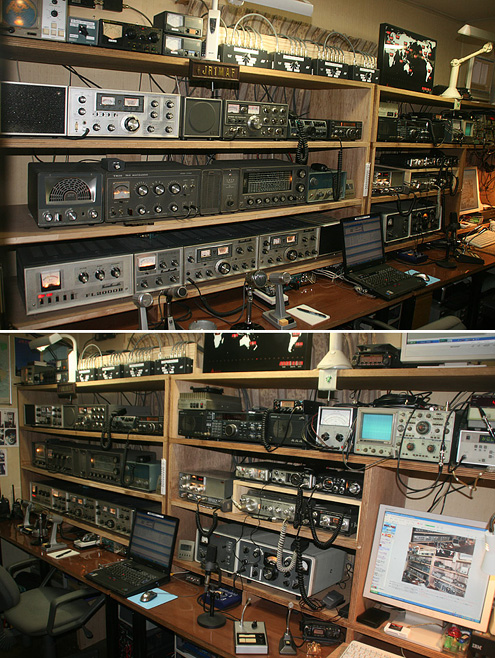 @
@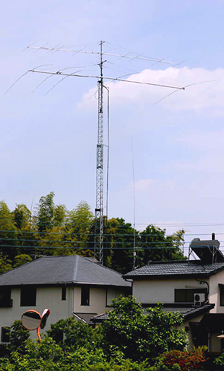
==> You can see the updated details in the page of "Facilities of the Base Station" in the sub-menu at the left.
== Autumn, 2010 ==
Homebrew "All tube AM/CW transmitter and receiver", which is a symbol of the nostalgia, has been completed, and I got into the serious homebrew world.
Althoug a 80m antenna has been always a pending problem, but this time, I put up a homebrew rotary dipole (17m long, 8.5m for each side.) with ICOM's ATU AH-4 at the feeding point. This antenna works really nice, and now I have no problem at all working 80m for domestic QSOs.
Antenna system is now well ordered. They are 3.5MHz rotary dipole (homebrew) for domestic QSO, 14MHz 5 element Yagi (homebrew) for DX QSO, 430MHz 13 element Yagi stacked (CREATE) for local QSO, and 50MHz 10 element Yagi (homebrew) for all round purpose.
In addition to the above projects, I purchased ICOM's DSP transceiver IC-756PRO3 (As IC-7600, a successor of IC-756PRO3 was sold in the same marked price in parallel, I could buy IC-756PRO3 at almost 50% discount from the marked price!), for valuation of homebrew rigs, and for emergency back up for all the equipment in the shack.
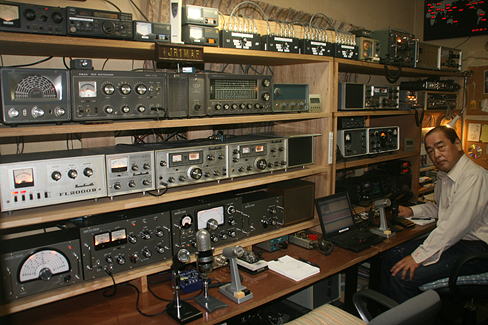
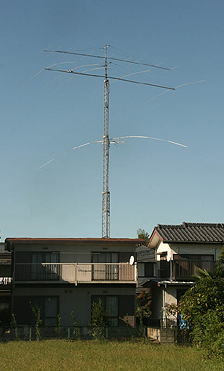
==> Please see details about homebrew equipments in the page of "Homebrew Factory" in the sub-menu at the left.


 In case you hit this
page directly from a Search Engine, you can reach to all of the pages of MAFNET from Top Page
In case you hit this
page directly from a Search Engine, you can reach to all of the pages of MAFNET from Top Page
























 @
@

